The beautiful gardens way up the California coast near Mendocino are off the beaten path if you’re just visiting San Francisco. It’s about 100 miles north and over a set of low mountains or accessed by the very windy 2-lane highway that traverses most of the California coast. If you’re ever there, do make a pilgrimage. It’s very worth it. You’ll notice the sun wasn’t even shining, but there was plenty of light to take photos.
Archives
Recent Posts
Currently Reading
Tasting Spoons
Posted in Salads, on July 18th, 2015.
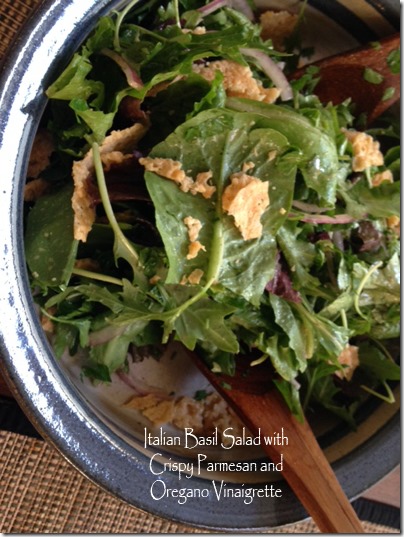 If you need a refreshing salad – with greens of all kinds, and some lovely basil leaves – this may be one you’ll want to try. It’s loaded with goodness, and the star of the show are the little crumbles of baked Parmesan. Ever made them before? Easy. And it will make the salad very special.
If you need a refreshing salad – with greens of all kinds, and some lovely basil leaves – this may be one you’ll want to try. It’s loaded with goodness, and the star of the show are the little crumbles of baked Parmesan. Ever made them before? Easy. And it will make the salad very special.
I just posted about a trip I took in May (no, not the Europe trip, this was one to Northern California), one I will write up one of these days. There were lots of photos to share of the California coastline, wildlife, flowers at a Botanical Garden in Ft. Bragg (way up north) and my older granddaughter’s graduation from high school.
Anyway, while visiting in the Bay Area I went to see old friends I’d not seen for some years. The last time was several years ago when they were living in Pennsylvania and Dave and I stayed with them. Now Karen, Phil and their 2 sons, Cameron and Ryan are back on home (California) turf again and Phil’s got a new very high-powered job in the tech industry. Phil used to work for Intel, my DH’s employer. When Phil was almost fresh out of MBA school and came to work for Intel, he spent some weeks shadowing Dave in outside sales. Most of the new kids on the block did that when they were first sent to this local SoCal office.
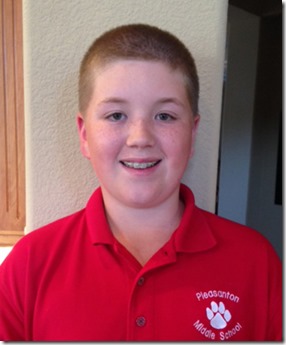 Phil & Karen invited me to their home in Pleasanton – a gorgeous house set amongst a winery enclave. They grilled thick halibut steaks (and we talked about what a real treat halibut is these days at upwards of $20/pound). And their son Cameron (pictured at right) made this marvelous salad. Cameron likes to cook – isn’t it wonderful when your kids take an interest and really want to help in the kitchen?
Phil & Karen invited me to their home in Pleasanton – a gorgeous house set amongst a winery enclave. They grilled thick halibut steaks (and we talked about what a real treat halibut is these days at upwards of $20/pound). And their son Cameron (pictured at right) made this marvelous salad. Cameron likes to cook – isn’t it wonderful when your kids take an interest and really want to help in the kitchen?
The recipe came from Chef Michael Smith’s Kitchen: 100 of My Favorite Easy Recipes.
A few hours before you want to serve the salad (or even a day or so ahead) you need to make the Parmesan crisps. Click here if you want to see Ina Garten’s video of how to make the crisps. Super easy. But do start with the good stuff, Parmigiano-Reggiano or maybe a very good Pecorino. Nothing less will do. Once baked and cooled, keep them in an airtight container.
The dressing is very easy – it’s the usual salad dressing stuff with a tetch of honey to give it some sweetness. I liked that about this recipe, and not one you often see in an Italian dressing. Usually they’re acid-heavy and consequently, very tart. This one is lovely – smooth and nice. And truly, the Parm crisps make it. Thank you, Cameron, for sharing your recipe with me!
What’s GOOD: the Parmesan crisps are the best part about the salad, no question. They add texture and wonderful deep flavor, so don’t under any circumstances skip that part of it. Have everything else all ready to go and the salad is done in a flash.
What’s NOT: really nothing, unless you can’t set aside the time to make the crisps – that would make this salad very ordinary!
Files: MasterCook 5+ and MasterCook 14 (click on link to open recipe in MC)
* Exported from MasterCook *
Italian Basil Salad with Crispy Parmesan and Oregano Vinaigrette
Recipe By: Chef Michael Smith’s Kitchen (cookbook)
Serving Size: 4
4 ounces Parmigiano-Reggiano cheese — (125 g) grated
6 ounces baby greens — (175 g)
2 cups halved cherry tomatoes — (500 mL)
1 cup fresh basil leaves — whole (250 mL)
1 cup Italian parsley — leaves and tender stems (250mL)
2 whole green onions — thinly sliced
A sprinkle or two of salt and lots of freshly ground pepper
DRESSING:
2 tablespoons extra virgin olive oil — (30 mL)
1 tablespoon red wine vinegar — (15 mL)
1 tablespoon Dijon mustard — (15 mL)
1 tablespoon honey — (15 mL)
1 teaspoon dried oregano — (5 mL)
1. Preheat oven to 350°F (190°C).
2. Lightly oil a baking sheet, then evenly sprinkle on a thin layer of the Parmesan cheese, forming a circle 8 inches (20 cm) or so wide.
3. Bake until golden brown and crispy, about 10 minutes. Set the baking sheet on a rack to cool. Break the cheese into large chunks. (You can crisp the cheese several days in advance and store in an airtight container at room temperature.)
4. Just before serving, in a festive salad bowl, whisk together the oil, vinegar, mustard, honey, and oregano until they form a smooth vinaigrette. Add the greens, tomatoes, basil leaves, parsley leaves, and green onions.
5. Season to your taste with salt and pepper. Toss everything together and top with the crispy Parmesan.
Per Serving: 116 Calories; 7g Fat (52.8% calories from fat); 3g Protein; 12g Carbohydrate; 3g Dietary Fiber; trace Cholesterol; 76mg Sodium.
Posted in Restaurants, Travel, on July 17th, 2015.
On my driving trip to Northern Cal, I stayed just one night in Sonoma. It’s a very cute little town – there’s a photo I found online at sonomavalley.com, of the main square or plaza. My B&B was about a block off to the top right – so easy to walk into town. Sonoma still retains its old world charm and almost frontier character. I wasn’t there for the wine – my darling DH was probably chiding me from heaven to have me stop at this or that winery, but I wasn’t there to do tasting or buying, especially since it was summer (hot) and any wine would have to stay in the car for the next several days (not good). There’s a special table/décor store on the plaza (top at the center) that I wanted to visit, but it was closed by the time I walked there, and I left too early the next morning to do any shopping.
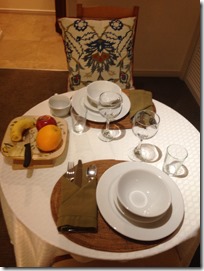 Here’s a photo of the table in my room at the Cottage Inn and Spa, where I stayed. The B&B is a combination of two old Spanish homes, side by side, with just charmingly decorated rooms. I stayed in the Courtyard Suite, a small but cozy room with a tiny but well outfitted kitchen and a view (if my door was left open) of the courtyard and fountain.
Here’s a photo of the table in my room at the Cottage Inn and Spa, where I stayed. The B&B is a combination of two old Spanish homes, side by side, with just charmingly decorated rooms. I stayed in the Courtyard Suite, a small but cozy room with a tiny but well outfitted kitchen and a view (if my door was left open) of the courtyard and fountain.
Breakfast was delivered (a pretty covered basket) to a hook outside my door and I made a good pot of coffee to go with it. Very nice.
The little B&B has one distinction – there is only one room with a TV. I read my book and slept like a log.
I asked for a recommendation for dinner and they sent me to the #1 Trip Advisor result, Café La Haye, which is just off the main plaza by about 60 paces. I went early and had a fabulous meal. I put together the photos in a collage – see below.
My dinner comprised two different small dishes – the beet salad on a bed of crème fraiche (I think) and topped with a lovely mound of dressed greens. It was to die for. I sat at a bar (see 2nd picture, small bar at bottom right) that overlooked the kitchen.
My 2nd course was toasted polenta slices (that were very moist) on a bed of something (can’t recall) and topped with shaved fennel and onions and a lovely sauce. I nearly licked the plate clean.
Then I splurged and had their rum raisin gelato/ice cream which was meant to go with a special dessert, but they ran out of the dessert, so I just had the gelato. Oh my, delicious.
When I left, it was still early, so I took a long stroll around all the stores on the perimeter of the plaza. I looked in windows, and browsed inside if the stores were open (some were). The town was busy with visitors and locals.
A charming town. I enjoyed my B&B and my dinner.
Posted in Travel, on July 16th, 2015.
Have you ever been to Morro Bay? It’s a lovely little, sleepy seaside town about 2 1/2 hours north of Los Angeles. And that, the great, gigantic rock, sits out from the shore about 3/4 of a mile or so. It’s certainly the focal point of this town.
It’s been several weeks ago now – actually it was at the end of May, and I’m just getting around to writing up about my 2-week driving trip to Northern California. Life got in the way, but first I needed to write up all the different posts about my Europe trip in March/April. As I write this I’m packing my suitcase to fly to Colorado to visit with friends for about 5 days, so maybe I’ll have some photos from there as well. I’ll get those up after I finish this trip . . .
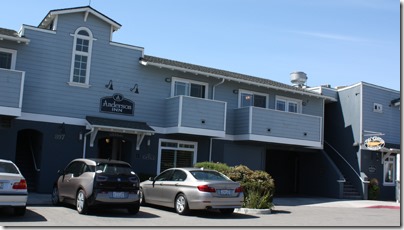 Once through the awful traffic of L.A. (it gets worse by the day, and traffic in Orange County, where I live, is getting worse too) it was easy driving on up north. I like driving – at least for awhile I don’t mind driving by myself. During one part it wasn’t much fun, but I’ll tell you about that later. After driving through Oxnard and Pismo Beach, eventually I got to Morro Bay. I’d booked myself into a really, really lovely place called The Anderson Inn (it’s not a B&B, no breakfast). I wished I’d paid for the highest priced rooms that overlook that view up at top. I didn’t – I just couldn’t quite bring myself to do it – it’s not cheap! – so I had a very partial view of the rock from a tiny deck outside my sliding door. The room was lovely – outfitted well – and the owner even asked me if I liked cream in my coffee (yes, I do) and she brought me a pitcher of real cream that was stored in the room refrigerator. Oh my, was I impressed.
Once through the awful traffic of L.A. (it gets worse by the day, and traffic in Orange County, where I live, is getting worse too) it was easy driving on up north. I like driving – at least for awhile I don’t mind driving by myself. During one part it wasn’t much fun, but I’ll tell you about that later. After driving through Oxnard and Pismo Beach, eventually I got to Morro Bay. I’d booked myself into a really, really lovely place called The Anderson Inn (it’s not a B&B, no breakfast). I wished I’d paid for the highest priced rooms that overlook that view up at top. I didn’t – I just couldn’t quite bring myself to do it – it’s not cheap! – so I had a very partial view of the rock from a tiny deck outside my sliding door. The room was lovely – outfitted well – and the owner even asked me if I liked cream in my coffee (yes, I do) and she brought me a pitcher of real cream that was stored in the room refrigerator. Oh my, was I impressed.
I had time to walk up and down the main street of the wharf, to look in all the corny tourist shops. I didn’t buy 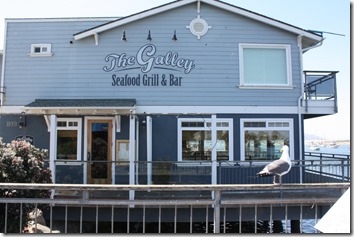 anything although I visited one really nice gardening and décor store that had some lovely stuff. I had dinner early, at The Galley, a restaurant that’s attached to the inn (and you can see the 2nd floor deck for the inn’s view rooms, the ones I didn’t stay in – there are 4 of them up there, overlooking the harbor).
anything although I visited one really nice gardening and décor store that had some lovely stuff. I had dinner early, at The Galley, a restaurant that’s attached to the inn (and you can see the 2nd floor deck for the inn’s view rooms, the ones I didn’t stay in – there are 4 of them up there, overlooking the harbor).
It seems to be my modus operandi as a widow, when I eat out, to eat early – I feel awkward going to dinner at 7 with romantic couples and families everywhere. I shouldn’t, and I’ve tried not to, but I just do. So I was finished with dinner by about 6:30 and had time to take a nice walk. It was brisk that day and I enjoyed the cool ocean breezes.
The next morning I had breakfast down the street at a very old-fashioned (but good) diner, and I got on the road early. Because of some fast, last minute texting with my friend Cherrie, when I got to Cayucos (ky-YOU-kos), 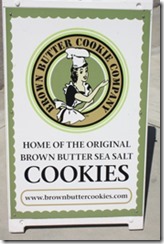 just north or Morro Bay, I pulled off and drove into the 2-block long main drag and stopped at a very special destination – the Brown Butter Cookie Company. They have a store in Paso Robles and this one in Cayucos. They offer samples too. I’d tasted their cookies before – and knew
just north or Morro Bay, I pulled off and drove into the 2-block long main drag and stopped at a very special destination – the Brown Butter Cookie Company. They have a store in Paso Robles and this one in Cayucos. They offer samples too. I’d tasted their cookies before – and knew 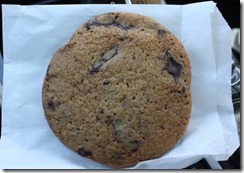 they were sensational (yes, lots of butter). Most of their cookies are sort of a shortbread kind of dough, although I had chocolate chip, and that was not.
they were sensational (yes, lots of butter). Most of their cookies are sort of a shortbread kind of dough, although I had chocolate chip, and that was not.
I’d just had breakfast, but for the sake of research, I bought one cookie to eat myself. I bought several others – small packages of 6 cookies in bags of 4 different types. They made for a very nice hostess gift for 2 different friends I was going to stay with in coming days.
My destination that day was Carmel, but I drove old Highway 1, a very curvy road that’s been in existence for more than a century, I’m sure. Hearst Castle is along the way, though I didn’t stop there – have been there several times. I 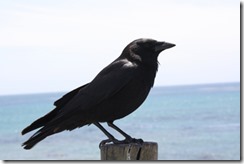 just headed north, plugged in a CD to listen to a book on tape (that day it was Under Magnolia, the memoir by Frances Mayes). I don’t mind the curvy roads, but I found that I didn’t enjoy it that much because I couldn’t crane my neck around to see the views – I had to keep my eye on the road. I didn’t have anyone to tell me to stop at the next turnout, etc. I think the better viewpoints are seen driving south, not north. I don’t know that I’ll ever do that drive again. On the way, though, there are some lovely places to stop. I got out to stretch my legs and encountered this relatively friendly raven. Had I moved any closer he’d have flown off – he kept his eye on me every second as I approached. He didn’t even flinch when the shutter clicked.
just headed north, plugged in a CD to listen to a book on tape (that day it was Under Magnolia, the memoir by Frances Mayes). I don’t mind the curvy roads, but I found that I didn’t enjoy it that much because I couldn’t crane my neck around to see the views – I had to keep my eye on the road. I didn’t have anyone to tell me to stop at the next turnout, etc. I think the better viewpoints are seen driving south, not north. I don’t know that I’ll ever do that drive again. On the way, though, there are some lovely places to stop. I got out to stretch my legs and encountered this relatively friendly raven. Had I moved any closer he’d have flown off – he kept his eye on me every second as I approached. He didn’t even flinch when the shutter clicked.
This scene is very typical of the California coast – we’re in a severe drought, though, so where the fields might have been green, they’re brown this year. The flowers are weeds, I think, but they’re pretty nonetheless.
One place I always stop is a sea lion overlook. It’s marked with a sign, and this time of year there are hundreds 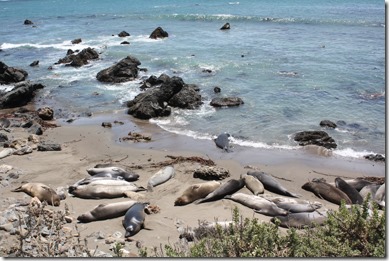 of sea lions lounging on the shore with hundreds of people standing around and gawking and making funny faces because it smells. I joined the crowds and snapped a few pictures and observed one of the males maneuvering himself to an open spot. They are so gangly and awkward – it’s amazing they can roll themselves on land.
of sea lions lounging on the shore with hundreds of people standing around and gawking and making funny faces because it smells. I joined the crowds and snapped a few pictures and observed one of the males maneuvering himself to an open spot. They are so gangly and awkward – it’s amazing they can roll themselves on land.
The picture doesn’t do justice to the noise – they are barking off and on all the time – and they move around, flap a little to ward off flies, probably, and the water laps at their tails. It was blowing like crazy – I know, you can’t tell – so I didn’t stay there long.
I made several short stops, snapped some pictures, most of which weren’t worthy of posting except those 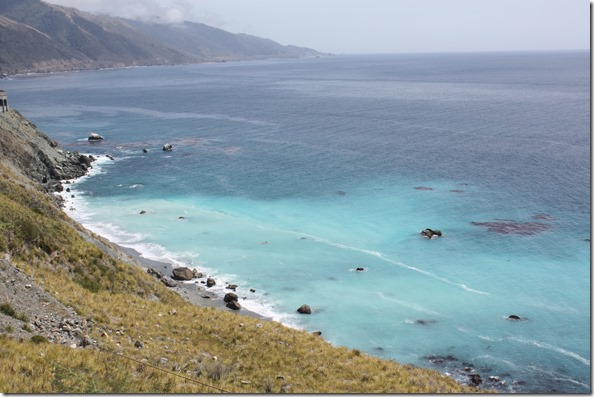 you see here. I stopped at one pull-out along the coast and loved the interplay of colors in the water. It was cold, and yes, the wind was blowing. That’s the scene looking south, obviously.
you see here. I stopped at one pull-out along the coast and loved the interplay of colors in the water. It was cold, and yes, the wind was blowing. That’s the scene looking south, obviously.
I spent the night in Carmel, at the rather famous Doris Day pet-friendly hotel right in downtown, called the Cypress Inn. It’s a block off the main drag, and has a lovely old-world, almost European elegance about it. I had an exceedingly small room there – by the time I booked it a month before I went, all the rooms I’d previously looked at and liked were taken. Oh well. I had another early dinner at the restaurant in the hotel and then had time to walk the complete town – up, across, down and back, the length of the main street. Nearly all the stores were closed, but I managed to return the next morning to a store I liked that had raincoats. Not that I needed a raincoat, but I really liked a bright red one. That went into the trunk of my car and never got used – still hasn’t been used since it’s summer! The next morning I had to climb over dogs in the lobby to get to the breakfast bar. There were dogs everywhere (not in the room with the food, however).
After that I drove to Santa Clara and stayed overnight with my cousin Gary, then visited with friends Stacey & Russ and their children, then spent 2 nights in Lafayette and used a nice hotel as a central place to go visit another cousin Maxine and her husband Jim, and Karen & Phil, lunch with one of Dave’s old-old friends, a previous boss and sailing partner and his wife, Bob & Monique, then with another couple who were also close friends during Dave’s days at Intel, Ron & Kim. I was VERY busy during those 5 days – with hardly a moment to myself, really.
Then I drove through wine country and met my cousin Gary in Healdsburg. We had lunch and then I drove us up  to Mendocino. I’d wanted to re-visit that town – it was one that my DH and I had visited about 5-6 years ago, and enjoyed. Gary had never been there, and it’s right in his neck of the woods. So he’d said yes, he’d like to go with me when I asked him to accompany me. It’s a kind of a sleepy seaside town and there’s not a whole lot to do there.
to Mendocino. I’d wanted to re-visit that town – it was one that my DH and I had visited about 5-6 years ago, and enjoyed. Gary had never been there, and it’s right in his neck of the woods. So he’d said yes, he’d like to go with me when I asked him to accompany me. It’s a kind of a sleepy seaside town and there’s not a whole lot to do there.
Gary and I stayed 2 nights and ate out of course. Nothing particularly memorable. We did visit a lovely botanic gardens in Ft. Bragg (about 4-5 miles north of Mendocino) and I’ll write up a separate post about that. Gary loves flowers and gardens and he spent hours and hours hiking the trails and taking hundreds of photos. I walked through it all and took some pictures, then spent some time at the little café reading, and enjoying an iced chai tea latte. For many of the daylight hours we were there it was shrouded in mist. Morning, noon and night, really, with some filtered sun shining through now and then. In the photo above, near our inn, is the bay just north of the town of Mendocino. You can tell it was overcast and misting.
After dropping Gary off in Healdsburg, where he left his car (and he went on home), I visited Sonoma State, the school where my 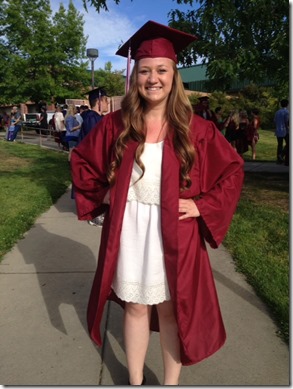 granddaughter Taylor will be going to college (she’ll major in nursing) this fall. I’m SO excited for her. I walked around the campus just to acquaint myself with the layout, and drove around the dorms. And visited the bookstore and bought a few things for Taylor. Then I drove on over to Placerville to attend Taylor’s high school graduation. Here’s a photo of her just before the ceremony.
granddaughter Taylor will be going to college (she’ll major in nursing) this fall. I’m SO excited for her. I walked around the campus just to acquaint myself with the layout, and drove around the dorms. And visited the bookstore and bought a few things for Taylor. Then I drove on over to Placerville to attend Taylor’s high school graduation. Here’s a photo of her just before the ceremony.
I’m so proud of this young lady – she’s overcome some tremendous odds and graduated with a really good GPA – and Sonoma State wants her! She was accepted at Chico State also, but opted for Sonoma – it’s a really beautiful pine-tree-filled campus.
The next day I surprised Taylor with a big gift – she so needs it – I bought her a car. Here at right you can see the photo of her after I purchased it (used, though it’s only 2 years old, a Honda Civic).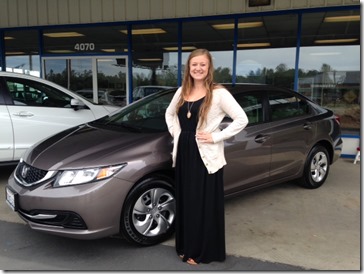
Can you tell how excited she was about that?
While I was at Sonoma State I bought her a decal that’s already installed in the back window of her car – I should have given her the decal first then told her I was going to take her somewhere where she could install it. No matter, she was thrilled. The college campus is about 2 1/2 hours away from home. She had an ancient Honda Civic with 250,000+ miles on it that was on its last legs, and certainly not up the task of taking her to/from school.
That was my trip – after a couple of days there I drove home. Another trip under my belt as a widow. I don’t really like traveling alone, but if I want to travel, I have to do it that way part of the time.
Posted in Books, on July 14th, 2015.
The sinking of the Lusitania in 1915 has held a traumatic place in history. It was a relatively newly built passenger liner and despite direct threats from the Germans that they could/would sink any military or merchant vessel, the Cunard line felt that cruise ships would be left alone and not bothered by the warring nations. Pipe dream, that.
Probably I’d never have read this book if it hadn’t been chosen by one of my book clubs. But that’s one of the joys of belonging to a book club with people of varied interests – you’re asked to read books that you might not ordinarily choose.
Erik Larson is the very well-respected author of several books, most notably The Devil in the White City: Murder, Magic, and Madness at the Fair That Changed America and In the Garden of Beasts: Love, Terror, and an American Family in Hitler’s Berlin
. What Larson does is collect the facts, copious amounts of them, and cull them down to write a very engaging story – the truth – about what really happened. Many information archives (both British and German) are now available for public perusal, and that in itself makes for very interesting reading,
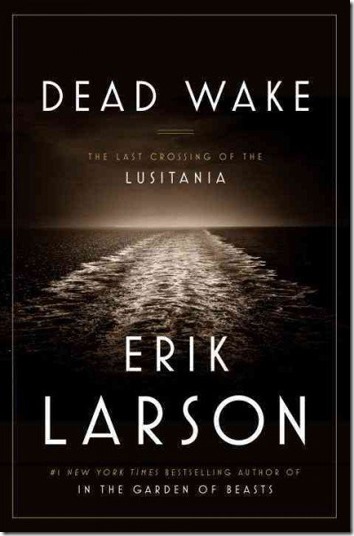 telling the true minute by minute action that occurred that fateful day off the Ireland coast when 1,198 people were drowned in the very rapid sinking of this flagship of the Cunard line. And the weeks leading up to the sinking. Many people survived, and its from them that even more information is known about exactly what happened on different decks or sides of the ship. About who acted well, and who didn’t. The Captain of the ship was presumed drowned, as he stayed with the ship until the ship sunk below the surface. He never expected to live, and only came to hours later. His career was marred because no one stood up for him, to share that he had no knowledge. It wasn’t his fault. Cunard had instructed the ship to reduce speed to save fuel (when speed could have saved them, yet the Captain did as he was instructed). No one told him to go north to avoid detection. A big snafu from everyone around.
telling the true minute by minute action that occurred that fateful day off the Ireland coast when 1,198 people were drowned in the very rapid sinking of this flagship of the Cunard line. And the weeks leading up to the sinking. Many people survived, and its from them that even more information is known about exactly what happened on different decks or sides of the ship. About who acted well, and who didn’t. The Captain of the ship was presumed drowned, as he stayed with the ship until the ship sunk below the surface. He never expected to live, and only came to hours later. His career was marred because no one stood up for him, to share that he had no knowledge. It wasn’t his fault. Cunard had instructed the ship to reduce speed to save fuel (when speed could have saved them, yet the Captain did as he was instructed). No one told him to go north to avoid detection. A big snafu from everyone around.
Reading such a book now, with the kind of technology we have from radar and sonar, and satellite, makes this book and the lack of knowledge for both the ship and the U-Boat amazing reading. I was riveted to the chronology, the messages (or lack thereof) between the Admiralty, the Cunard line to its Captain and the secret department in the British military who were deciphering coded messages from the U-Boats. Yet the information was never shared with the merchant ship for fear of disclosing the fact that the Brits knew of their intent. It could have changed the course of the war had they known. The woman who reviewed the book for us made a really interesting comparison about the sinking of the Titanic vs. the sinking of the Lusitania. So different in every aspect. Made for very interesting contemplation.
The book is on the best seller list, and rightly so. It’s a really good read, though the part detailing the passengers who drowned, fell overboard or had any variety of accidents in trying to save themselves was heartbreaking to read. If you buy this, be sure to scan through the last 40-50 pages of footnotes – they make fascinating reading all by themselves. It tells you, again, how thorough Larson was in researching the material.
Do you have food in the freezer that calls out to you? That sings your name and says “come hither?” Well, there’s a little box of these in my freezer and in the mid-afternoon when I need a pick-me-up, I swear, they start beckoning.
Not really, but they certainly could sing to me. These brownies. Oh my goodness. I’d forgotten all about these, about how fantastic they are, how chocolaty they are. I cut them into small pieces so I wouldn’t get carried away and I do take just ONE of them. I baked them for an event recently and hoped most of them would be eaten, but alas, there were about 15 of them left over. Oh, sigh. They’re in my freezer.
I posted this recipe back in 2007, a couple of months after I started writing this blog, and I waxed glorious about them then, and hadn’t made them since. It’s a recipe from Cook’s Illustrated – according to my notes it was published in 2004 and I think they call them Classic Brownies. The link at left is to my original post. The only thing different about this one is that I used walnuts instead of pecans.
There is one important point – DO use really good quality chocolate. I’m not sayin’ that these won’t be good if you use grocery store, cheaper chocolate. I had a chunk of Valrhona in my pantry and that’s what I used. It calls for unsweetened chocolate. Nothing about the preparation of these is difficult. There are dry ingredients.There are eggs, and then chocolate and butter that are melted together.
You can bake these in a 9×13 pan. Mine?: I used an odd shaped one. One of my cooking teachers recommended 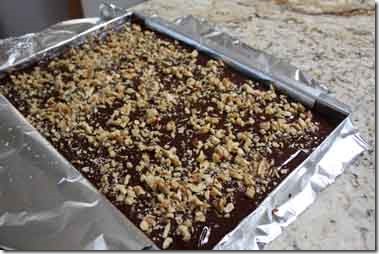 Magic Line, a U.S. company that produces real solid aluminum pans. They’re available on amazon in oodles of shapes and sizes. This one I used is a jelly roll pan, but I wasn’t making a jelly roll, obviously. What’s unique about Magic Line is the nice little lip they put on the edges, which makes it much easier to grab the hot pan out of the oven. Anyway, Parrish Magic Line 10 x 15 x 1 Inch Jelly Roll/Cookie Sheet
Magic Line, a U.S. company that produces real solid aluminum pans. They’re available on amazon in oodles of shapes and sizes. This one I used is a jelly roll pan, but I wasn’t making a jelly roll, obviously. What’s unique about Magic Line is the nice little lip they put on the edges, which makes it much easier to grab the hot pan out of the oven. Anyway, Parrish Magic Line 10 x 15 x 1 Inch Jelly Roll/Cookie Sheet is the one. In the photo at left I’ve lined the pan, both directions, with foil, with edges sticking out, to make it easier to remove once the brownies are cooled.
I wanted to have thinner brownies and more of them; hence I decided to use the larger pan. I baked them slightly less time, about 29 minutes, rather than 30-40 in the 9×13 pan. I used my Thermapen to check the internal temp and took them out when they reached 200° F. And, I used walnuts. I didn’t toast them – I was running low on time that day, so I took a shortcut. But toasting walnuts, or any nuts, before baking with them is a good idea.
What’s GOOD: everything about these is good, providing you like chocolate. The brownies are dense, but not gummy, and they’re just overflowing with good chocolate flavor. Now I remember why they’re called “best ever.” That was a designation from the folks at Cook’s Illustrated. You’ll hear raves, I promise you.
What’s NOT: nothing, unless you don’t have any good unsweetened chocolate on hand. These are worth making a trip to a specialty store to find the Valrhona. Or Scharfenberger would be fine too. Just use good chocolate, that’s all I ask!
Files: MasterCook 5+ and MasterCook 14 (click on link to open recipe in MC)
* Exported from MasterCook *
Classic Brownies (the best classic brownie ever)
Recipe By: Erika Bruce & Adam Reid, Cook’s Illustrated, 2004
Serving Size: 24 (or about 40 if you use the different pan size)
4 ounces walnuts — or pecans, chopped and toasted
1 1/4 cups cake flour
1/2 teaspoon salt
3/4 teaspoon baking powder
6 ounces unsweetened baking chocolate — chopped fine [I used Valrhona brand]
1 1/2 sticks unsalted butter
2 1/4 cups sugar
4 large eggs
1 tablespoon vanilla extract
1. Adjust oven rack to middle position; heat oven to 325°. Cut 18-inch length foil and fold lengthwise to 8 inch width. Fit foil into length of 13 x 9 inch baking dish (preferably glass), pushing it into corners and up sides of pan; allow excess to overhang pan edge. Cut 14-inch length foil and, if using extra-wide foil, fold lengthwise to 12-inch width; fit into width of baking pan in same manner, perpendicular to first sheet. Spray foil-lined pan with nonstick cooking spray. If using nuts, spread nuts evenly on rimmed baking sheet and toast in oven until fragrant, about 4-8 minutes. Set aside to cool. Whisk to combine flour, salt and baking powder in medium bowl. Set aside.
2. Melt chocolate and butter in large heatproof bowl set over saucepan of almost simmering water, stirring occasionally, until smooth. (Alternatively, in microwave, heat butter and chocolate in large microwave safe bowl on high for 45 seconds, then stir and heat for 30 seconds more. Stir again, and if necessary, repeat in 15-second increments; do not let chocolate burn.) When chocolate mixture is completely smooth, remove bowl from saucepan and gradually whisk in sugar. Add eggs one at a time, whisking after each addition until thoroughly combined. Whisk in vanilla. Add flour mixture in 3 additions, folding with rubber spatula until batter is completely smooth and homogenous.
3. Transfer batter to prepared pan; using spatula, spread batter into corners of pan and smooth surface. Sprinkle toasted nuts (if using them) evenly over batter and bake until toothpick or wooden skewer inserted into center of brownies comes out with few moist crumbs attached, 30-35 minutes, or until the brownies are at about 200° F on an instant-read thermometer. Cool pan on wire rack at room temperature about 2 hours, then remove brownies from pan by lifting foil overhang. Cut brownies into 2-inch squares and serve. Store leftovers in airtight container at room temperature up to 3 days (they won’t last that long!). NOTE: I used a 10x15x1 jelly roll pan to bake these, so it made about 40 brownies. When using that sized pan, they baked for about 29 minutes.
Per Serving (if making 24): 224 Calories; 13g Fat (50.2% calories from fat); 3g Protein; 26g Carbohydrate; 1g Dietary Fiber; 51mg Cholesterol; 73mg Sodium.
Posted in Salads, on July 6th, 2015.
Need a refreshing salad for a warm/hot summer night? The humidity in our neck of the woods has been pretty much in the 70s and 80s in recent weeks, which is very unusual for California. Perhaps you folks in the East scoff at 70% humidity. At any rate, if you want a cold salad that’s filling and delicious, and really simple, just have on hand some canned tuna, green beans, some eggs, mint, basil and some kind of pasta.
I’ve been reading a new blog – well, it’s not a new blog, but it’s new to me. It’s called Manger, written by Mimi Thorisson. Among other things, her photographs are stunning. She lives in Médoc, France with her husband and 2 children. She’s written a cookbook too. I haven’t gone back into her recipe archives much, but I noticed a recipe she made that looked really nice for a warm summer evening. I cooked the green beans earlier in the day when it was cool in the kitchen. I did cook the pasta right before dinner, but that’s because I decided to add it. Mimi didn’t have pasta in her salad, nor did she include basil, or any mayo in the dressing. Or lemon juice, either So, I kind of improvised. I’d been hankering to make my favorite tuna salad, one that’s been in my recipe archive for a long time, credited to Joanne Weir, but Joanne says it’s not really her recipe. I swear it came from a cooking class I took decades ago at Sur la Table, and it was a compilation of some of the favorites from the Sur la Table kitchen school pros, recipes from a variety of different instructors, Joanne being one of them. You can find that recipe here on my blog too. It’s a pasta and tuna mixture, Sicilian Tuna Salad – that’s been a long time favorite. So I’d gathered up some of the ingredients, because I was going to make it, and then this salad stepped in front of my view, and it became my dinner.
I guess I should say – has it supplanted the Sicilian salad? No, I still like the Sicilian one better, but it’s definitely a pasta salad, whereas this one is more veggies and tuna with a few little pieces of pasta thrown in for texture. This one is very simple to make – prepare the dressing, but add some lemon juice – either in the dressing or drizzle some on the finished salad. Cook the green beans. Chop up the eggs, crumble the canned tuna, chop up some mint and basil and kind of layer the whole thing on a plate then drizzle the dressing on top. Done. Easy.
What’s GOOD: I liked how simple it was to make, and the addition of the green beans put it way up there in my estimation. You can leave out the pasta if you don’t want it. You’ve got protein and vegetables, then, and a drizzle of dressing and some powerful herbs (mint and basil) to give it tons of flavor. I put on lots of black pepper, and it needed some salt at the end also. But you could put this dinner together in less than 20 minutes including cooking the pasta and the green beans.
What’s NOT: It’s not a wow salad – not everything can be a wow. It was good. It was flavorful. It had lots of texture, and it was satisfying. All good enough reasons to make it.
Files: MasterCook 5+ and MasterCook 14 (click on link to open recipe in MC)
* Exported from MasterCook *
Tuna, Egg, Mint and Pasta Salad
Recipe By: Inspired by a recipe at Manger (blog)
Serving Size: 2
2 large hard boiled eggs
1 cup haricots verts — cooked, shocked in ice water
1/3 cup mint — chopped
3 tablespoons fresh basil — sliced thinly
2/3 cup cooked pasta
6 ounces canned tuna — [use really good quality tuna], drained, crumbled
1 tablespoon balsamic vinegar
3 tablespoons olive oil
1 tablespoon mayonnaise
1 tablespoon fresh lemon juice — approximately, enough to suit your taste
A dash of celery salt
Several dashes of pepper
1. Cut the stem end off the green beans, rinse well and cook for 4-5 minutes in salted boiling water, until just barely tender. Drain and set aside to cool. Chop into small bite-sized pieces. Set aside.
2. Prepare vinaigrette – mix olive oil, celery salt, pepper, mayo and balsamic vinegar . You can add more or less balsamic vinegar to your liking. Set aside.
3. Assemble salad with pasta on the bottom, tuna in the center, a layer of chopped eggs, then a layer of green beans. Sprinkle with chopped mint and basil just before serving and drizzle with vinaigrette. Serve immediately with more lemon juice squeezed over the top if desired. (You won’t use all the salad dressing.)
Per Serving (it’s high because there is more dressing than you’ll use): 495 Calories; 32g Fat (58.3% calories from fat); 32g Protein; 20g Carbohydrate; 4g Dietary Fiber; 240mg Cholesterol; 405mg Sodium.
Posted in Travel, on July 2nd, 2015.
Many tours of Paris include a visit to Giverny, the gorgeous small estate and gardens of the famed impressionist artist, Claude Monet. Back in his days there, he was a celebrated artist – a fame that came to him later in life.
In Monet’s earlier years he and his wife nearly died of starvation as they struggled to survive in a tiny garret in Paris. Yet never would he consider taking on some other occupation. He lived only to draw and paint. His first wife died (and he was both acclaimed and censored for painting his wife as she lay dead in their marital bed). Eventually he married again, and then finally he became an artist in favor. He’d made enough money to afford a lovely home and a staff to take care of this quiet, country piece of land on a narrow lane just north of Paris. Back then it was a ‘fur piece” to get there – now it takes about 45 minutes by car.
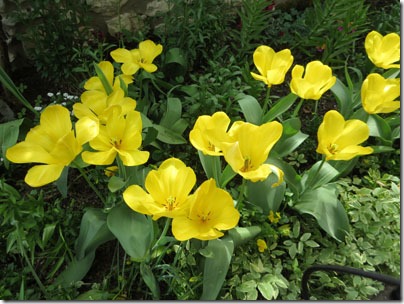 Over the years he expanded the gardens to include a piece of land that was across the road. Technically he owned it (so we learned on our tour) but nobody else built on theirs, but Monet did. The tour includes both sides of the road and you hardly realize that there IS a road in between. The townspeople must not have wanted to make waves, so they allowed his indiscretion of developing the garden. The road, in the photo at top is behind the ivy wall you can see about half way up. He dammed up a small pond (which is on the annexed garden) and planted flowers every which way. He painted nearly every day and everyone in the household left him alone when he was painting – it is what allowed them all to live there and be part of his large family. As long as he continued to paint and sell his paintings, the family lived in some level of French countryside splendor.
Over the years he expanded the gardens to include a piece of land that was across the road. Technically he owned it (so we learned on our tour) but nobody else built on theirs, but Monet did. The tour includes both sides of the road and you hardly realize that there IS a road in between. The townspeople must not have wanted to make waves, so they allowed his indiscretion of developing the garden. The road, in the photo at top is behind the ivy wall you can see about half way up. He dammed up a small pond (which is on the annexed garden) and planted flowers every which way. He painted nearly every day and everyone in the household left him alone when he was painting – it is what allowed them all to live there and be part of his large family. As long as he continued to paint and sell his paintings, the family lived in some level of French countryside splendor.
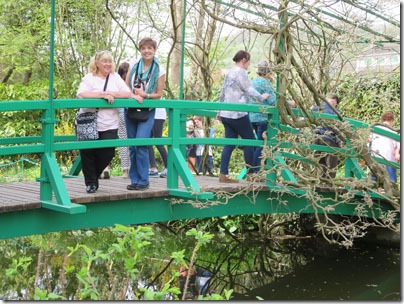 His gardeners kept the entire property thriving with seasonal flowers, built and planned along every path and wall to provide fodder for his paintbrush. The Monets entertained lavishly and often – there are cookbooks about the food they ate. Including the menus and recipes.
His gardeners kept the entire property thriving with seasonal flowers, built and planned along every path and wall to provide fodder for his paintbrush. The Monets entertained lavishly and often – there are cookbooks about the food they ate. Including the menus and recipes.
The bridge at left is quite famous in Monet-land. It’s in several of his paintings (Cherrie and Joan standing there in the middle).
Some of the trees, shrubs and flowers were labeled, but most of them were not. We guessed at some. I think one of the most interesting areas was the pond and in the middle of it there were very vocal frogs. I took a video, but am not very adept at the process of uploading it to my blog, so just trust me – it was very 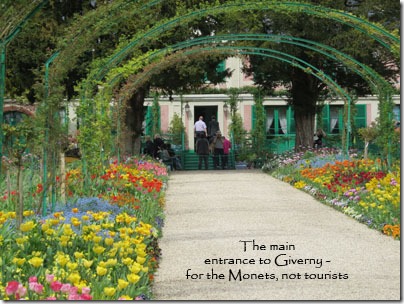 entertaining as the frogs called to each other from one lily pad to another and males protected their territory with skirmishes going on nearly every minute. Or, maybe it wasn’t male-male skirmishes, but male to female lovers’ calls.
entertaining as the frogs called to each other from one lily pad to another and males protected their territory with skirmishes going on nearly every minute. Or, maybe it wasn’t male-male skirmishes, but male to female lovers’ calls.
As we meandered around the paths, we eventually made it into the main gardens in front of the house. This pathway you see at right is cordoned off so visitors can’t walk there (you had to walk around the outside edges), but it makes for a prettier picture, I think.
In the heart of summer, most likely the climbing plants and flowers completely cover those canopies.
Flowers, pretty pastel spring flowers, were in abundance, in small clumps, mixing in more than one color or type, as at left with pink tulips and whatever the little blue flowers were. Can’t remember, nor can I tell from the photos.
Eventually we ended up going into the front door of the house (straight ahead in the photo above. Docents (French speaking only, of course) were in every room to make sure nobody stepped out of line or touched things. Monet and his wife slept in separate bedrooms, and actually the house wasn’t as big as I thought. Perhaps there are other rooms in the house that we didn’t see, more rooms for guests.
I’ve read that once a week – I think it’s on the day the estate is closed to the public – it’s open to artists who wish to come and paint in Monet’s footsteps. I’ve never done plein air painting (meaning out in the open, in nature), though every summer here where I live in Southern California, there is a workshop and competition for plein air.
Having heard about and read (I own the original Monet cookbook) some about the Monet family feasts, I was very intrigued to see the stunningly beautiful dining room. The house itself has been left completely as it was when Monet lived there (well, they keep it up, obviously, because it’s a huge money-maker). I have no idea if Monet’s descendants are involved, or are even alive. I don’t think I’ve ever heard.
The photo at left, with the rowboats, was one of my favorite scenes at Giverny. Monet painted angles of that numerous times. If you go on the ‘net and look, you’ll find so many paintings of different places all over the estate. There’s something so peaceful about the rowboats, and the still pond, and the bamboo (I think) growing up behind them.
My Monet cookbook resides up in my office (meaning that it isn’t one I use much). I found that the recipes were kind of bland. Plain. And that’s not my style particularly, but the book is big, with lots of photographs of Giverny, and I have a hankering to look through the pages again, to remember my walk through the gardens, this view and that.
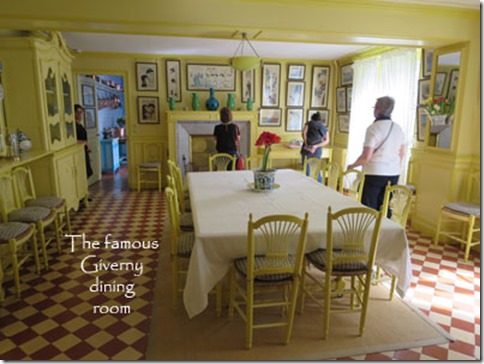 The Monet dining room is all in yellow, and it’s a very bright and cheerful room. Big. Because there were many extra chairs sitting around the edges, I think the table could accommodate more people if they needed to. The floors were beautiful. The furniture was all painted yellow. The floors that unique brick-red and white checkerboard. You can see the doorway into the kitchen beyond.
The Monet dining room is all in yellow, and it’s a very bright and cheerful room. Big. Because there were many extra chairs sitting around the edges, I think the table could accommodate more people if they needed to. The floors were beautiful. The furniture was all painted yellow. The floors that unique brick-red and white checkerboard. You can see the doorway into the kitchen beyond.
Loved the yellow and crimson tulips that were just in their final days of bloom. I wanted to cut off about a hundred and vase them in my kitchen.
The kitchen was so cool (in blue) and airy, with the gorgeous copper pots hanging around. I suspect the table you see in the foreground was the main work surface. I think the tile wall is Delft, and I found it interesting that they combined the blue-blue (like a marine blue) of the tiles and the turquoise trim color. To me they don’t go together at all. I’m sure Monet decided that color – very little was left to chance or to Mrs. Monet.
There is the cooking wall – with different Delft tiles surrounding the stove. And would you take a look at that stove? Like a gigantic Aga, but surely it was wood burning. But I don’t know that – just assuming that it was wood or coal burning. With so many different cubbyholes for heating, warming and baking.
Off to one side of the gardens was a very large gift shop, and although I tried to find some things I wanted there, the only thing I bought was a plastic shopping bag (that cost me about $3.00 U.S.) with one of Monet’s lily pad pond scenes on it. I take it to the grocery store and cart food into my kitchen. They had lots of Monet books – oodles of them, but I didn’t buy one.
There at left is Monet’s art studio. It was gigantic – by far the biggest room in the house. On the walls are painted replicas of his paintings, all stuck chock-a-block on ever surface. It was connected to the house, but down several stairs to get there. I’d have liked to really study the room more, but it was quite crowded, as you can see.
All of us really enjoyed the gardens – it was a lovely afternoon, the sun shone but it wasn’t too hot (this was early April). We were fortunate that we had no rain – we didn’t have rain at all on the trip.
Can I just tell you that you have to make these and leave it at that? No, you probably won’t believe me, will you? I don’t use that kind of forceful declaration very often. Well, just believe me, okay?
Often I’m led down a cooking path by the description of a recipe. Maybe it’s something unusual about it – or in it – that piques my interest. Other times it’s because there’s such an interesting background story about it. Or maybe it’s a homegrown recipe from way back. In this case, it’s Molly Wizenberg, of Orangette blog, cookbook fame, and her husband’s restaurant Delancey fame too. I’ve always admired Molly’s writing – she has a gift of building up a great story and I was following her long before she became famous. I read her blog and liked it. This recipe came from her column in Saveur.
And I got hooked on it because of the story. She and her family were on a drive in Washington, and her daughter was hungry. So was everyone in the car and most of the stores were closed in Edison. They found Breadfarm was about to close – they grabbed some things and dived into the bags as they stood in the parking lot. What emanated from them all were ooohs and aaahs. But it was the little package of freshly baked graham crackers that made the biggest impression. They were gone before she arrived home. And, because you’re Molly Wizenberg, you obviously can pick up the phone and tell the people at Breadfarm that you want to feature them and their recipe in an article in Saveur.
I’m ever so glad she did. Normally I’d probably not make home made graham crackers. Crackers, in  general, are a lot of work, and one meal, usually, and they’re gone. But Molly just made this graham cracker/cookie sound so divine that there just wasn’t anything to do but make these. First, however, I had to go shopping. I don’t stock whole wheat flour much – it turns rancid so quickly (the remainder is in the freezer for now). And I certainly had never used whole wheat pastry flour. Had to go to two stores before I found those items. It also uses wheat bran – another thing I don’t keep on hand because it doesn’t keep all that long, either.
general, are a lot of work, and one meal, usually, and they’re gone. But Molly just made this graham cracker/cookie sound so divine that there just wasn’t anything to do but make these. First, however, I had to go shopping. I don’t stock whole wheat flour much – it turns rancid so quickly (the remainder is in the freezer for now). And I certainly had never used whole wheat pastry flour. Had to go to two stores before I found those items. It also uses wheat bran – another thing I don’t keep on hand because it doesn’t keep all that long, either.
Fortunately I read and re-read the recipe before I began to make them. Making these requires several visits to the freezer as the precious little graham cracker cargo are chilled and slightly frozen before baking. I was home anyway, so I was certain to make these at a time when I would have no distractions.
My kitchen freezer is very full. (Actually, this is a mini form of hoarding, I think – I can’t seem to ever get my freezer to some manageable amount of fullness – it’s always chock full.) So I had to slide the cookie sheets with the rolled out cookies/crackers on parchment into my garage freezer (yes, there is room there). It required 2 visits to the freezer, and technically they were supposed to have a 3rd visit, but I did a shortcut on that one.
The batter is easy enough to make – you cream the butter, sugar (she calls for cane sugar, I used moscovado) and honey for awhile, then add the dry ingredients in 3 separate additions and continue mixing until it pulls away from the workbowl using the stand mixer. The batter is divided in half and pressed into a 1-inch thick rectangle on parchment. A 2nd piece of parchment goes on top and a rolling 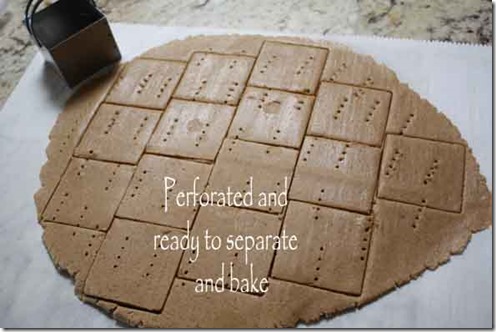 pin is used to squeeze down the dough to 1/8 inch thickness. The recipe says to keep the dough in its rectangular shape. Well, I couldn’t do that – I was handling it too much, so I just lived with the results of an oval shape and re-rolled the scraps. Some time was spent in the freezer, then you poke the crackers with a fork and either perforate the dough into squares, or in my case, I used a square cookie cutter, which worked just fine. Back into the freezer they go, so they’re cold-cold before you bake them. They are separated and placed on a parchment-lined baking sheet. And they’re baked.
pin is used to squeeze down the dough to 1/8 inch thickness. The recipe says to keep the dough in its rectangular shape. Well, I couldn’t do that – I was handling it too much, so I just lived with the results of an oval shape and re-rolled the scraps. Some time was spent in the freezer, then you poke the crackers with a fork and either perforate the dough into squares, or in my case, I used a square cookie cutter, which worked just fine. Back into the freezer they go, so they’re cold-cold before you bake them. They are separated and placed on a parchment-lined baking sheet. And they’re baked.
And I remind you – you have to make these. They’re just SO good. They’d be loverly with cheese as an after-dinner course. I’m serving them with my lemon velvet gelato on Father’s Day – this won’t post until a week or so later.
What’s GOOD: the taste. Oh my yes, they taste wonderful. And although you will have spent more time than usual making a batch of these, you’ll be glad you did, if you can make the time to do it. They make a very nice snack, or a straight-out cookie. And maybe you’ll think it’s not so bad because it’s almost all whole wheat flours.
What’s NOT: nothing whatsoever is bad about the cookie/cracker. It just takes a bit of time to make. And they’re a little bit fussy – trying to get the dough flat and square as you roll it out – you don’t want them to be thicker on one side than the other, not only would they not bake evenly, but they’d look funny.
Files: MasterCook 5+ and MasterCook 14 (click on link to open recipe in MC)
* Exported from MasterCook *
Breadfarm’s Graham Crackers _ SAVEUR
Recipe By: From Molly Wizenberg’s blog, Orangette, and Saveur, 2015
Serving Size: 48
1 3/4 cups whole wheat pastry flour
1/2 cup whole-wheat flour
1/4 cup all-purpose flour
1 tablespoon wheat bran — plus 2 teaspoons
1 teaspoon baking soda
1/2 teaspoon kosher salt
1/2 teaspoon ground cinnamon
2 sticks unsalted butter — softened
2/3 cup unrefined cane sugar — or turbinado sugar [I used moscovado]
2 tablespoons honey
1. In a medium bowl, whisk the flours with the wheat bran, baking soda, salt, and cinnamon.
2. In the bowl of a stand mixer fitted with the paddle attachment, beat the butter, sugar, and honey on medium speed, stopping occasionally to scrape down the sides of the bowl, until the mixture is creamy, 2 minutes. With the mixer on low speed, add the dry ingredients in three batches, stopping as needed to scrape down the bowl, until the flour is fully incorporated.
3. Continue beating until the dough comes together around the paddle, pulling away from the sides of the bowl.
4. Scrape the dough out onto a work surface and gather into a ball. Halve the dough ball and place each half on a 12” x 16” sheet of parchment paper. Pat each half into a 1”-thick rectangle and then cover with another sheet of parchment paper, lining it up with the first. Using a rolling pin, roll each dough half between the sheets of parchment to an even thickness of 1/8”, maintaining its rectangular shape [this was very difficult to do, so I made do with a big oval shape]. Carefully transfer the two dough halves, still between the parchment sheets, onto two baking sheets and freeze for 30 minutes.
5. Remove each sheet from the freezer, and transfer the parchment-wrapped dough sheets to a clean work surface. Remove the top sheet of parchment from each, and working quickly, use a fork or skewer to prick the dough sheets at roughly 1-inch intervals. Using a pizza cutter or a sharp knife, score the dough into 2-inch squares. Trim the scraps, and reserve to use for re-rolling and making more cookies. Return the pricked and scored dough sheets, still in single, large sheets, to the freezer for 15 to 20 minutes, until very firm.
6. Position racks in the upper and lower thirds of the oven, and heat to 350°. Remove the chilled dough sheets from the freezer, and invert each onto a clean work surface. Peel away and discard the parchment paper and, working quickly, separate the dough sheets along the score lines, into individual squares. Place the squares onto three parchment paper-lined baking sheets, spacing them about 1 1/2 inches apart. Chill the squares on the baking sheets for 15 minutes.
7. Bake the squares for 14 minutes, until golden at the edges; rotate the baking sheets front to back and top to bottom halfway through cooking. Transfer to a rack and cool completely. Store in an airtight container at room temperature for up to 2 weeks. [I didn’t quite get 48 cookie/crackers out of my batch – probably because they were just a bit thicker than the 1/8 inch suggested – it’s hard to measure!]
Per Serving: 69 Calories; 4g Fat (49.7% calories from fat); 1g Protein; 8g Carbohydrate; 1g Dietary Fiber; 10mg Cholesterol; 46mg Sodium.
Posted in Uncategorized, on June 28th, 2015.
So what’s this, you’re thinking? Huh? Veggies and a pork chop? Well, no, it’s probably not all that significant to most people. But it was significant to me. In the last 15+ months since Dave passed away, my darling DH, I’ve done a bit of grilling – a few times I’ve done meat and once or twice I did some veggies. When friends have visited, I asked them to “man” the grill. It’s been awhile, though, since I’d done it myself. I wanted to grill the yellow squash, but it seemed like a waste to fire up the grill for just veggies. The same could be said for a pork chop. It could be done on the stove top.
I know the mechanics of grilling. I know about how hot the grill should be to sear meat, and how it needs to be lower to do veggies. I know about searing, then pulling the meat aside so it’s not over direct heat, but still leaving the grill up medium-high. But I’d never really done it. I own a bunch of barbecue/grilling cookbooks, and I’ve attended my fair share of grilling classes. But there’s a difference between book learning and actually hovering over the hot grill with tongs or a long-handled fork in hand. This time I did it. For me, that was a hurdle I needed to get to, up and over.
With Dave, I just gave him the instructions and reminded him of the finished temperature of the meat and he went with it. The grill was his friend. I don’t know that I can say that – yet – that the grill is my friend. I’m not exactly afraid of it, but it’s a big-honkin’ thing – it has enough surface to grill about 30 steaks, for sure. I used just two sections for this dinner – one for the veggies and one for the pork chop. But before I took them off the grill I snapped a photo. To say I’d done it. To savor the accomplishment. Maybe not a big thing for you, but it was for me!
And yes, the pork chop was cooked perfectly (yes, I was a bit proud!) and the veggies were just barely soft and had lots of grill marks. That basket made it very easy – I just stirred them every few minutes. I feel like I’ve graduated from grilling boot camp.
But then after I was done I turned the burners to high and put down the lid, with the intent to return in an hour to vigorously brush off the grates and turn off the burners. That was a trick Dave used to do. Guess what? I forgot all about it – discovered 24 hours later that the 2 burners were still on high. Gosh darn. Maybe I didn’t graduate from boot camp after all.





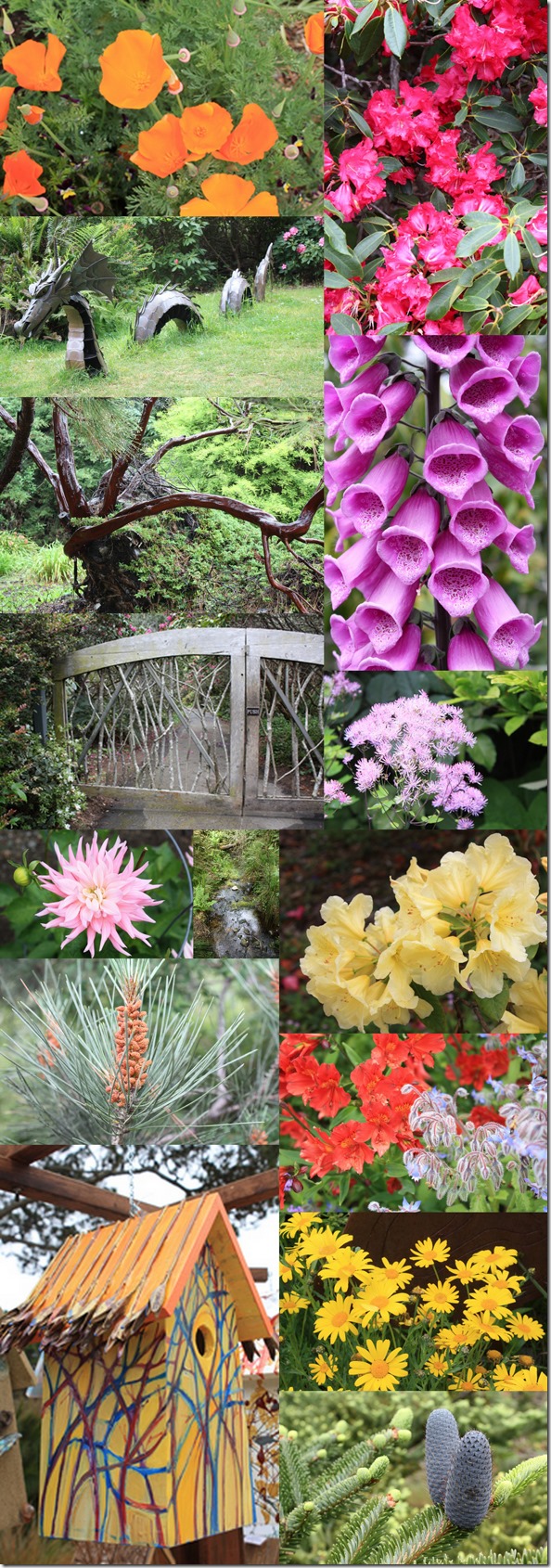

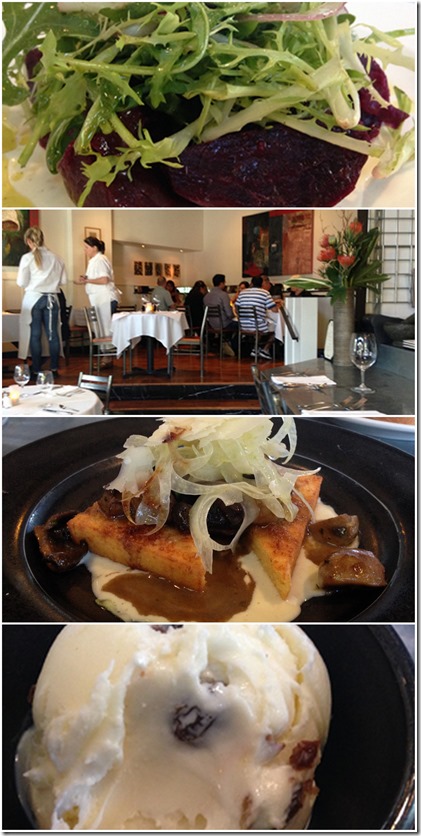
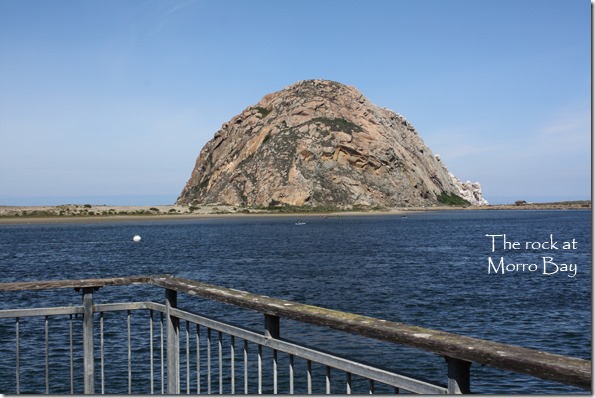

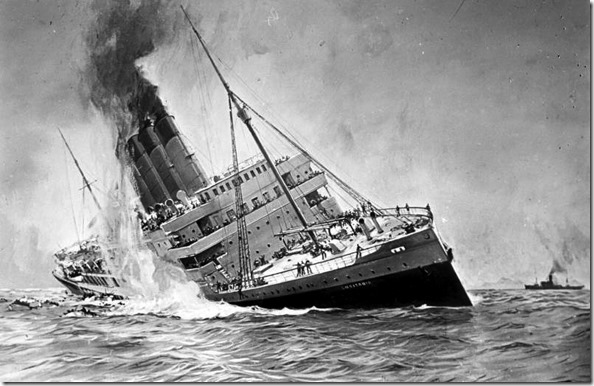
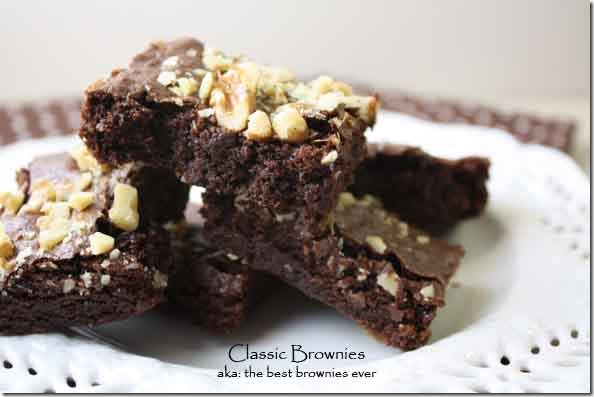
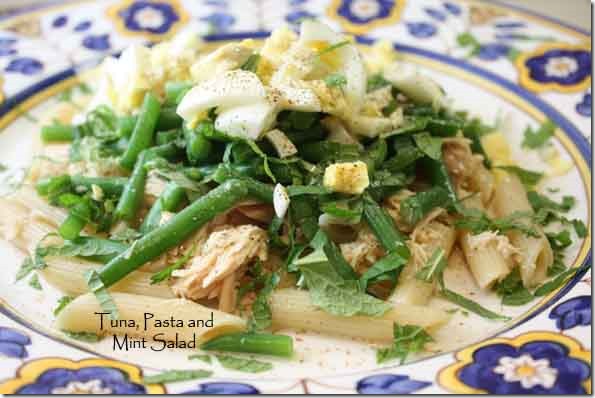
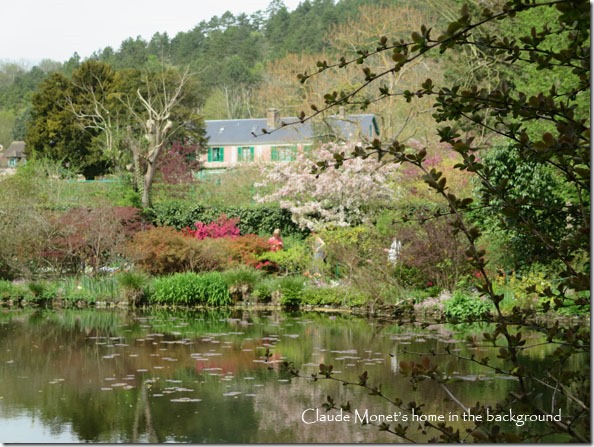
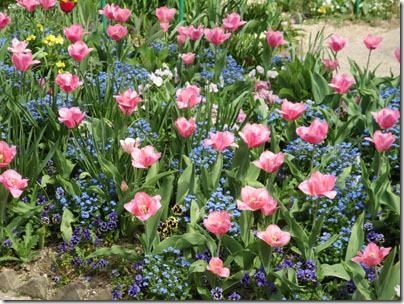
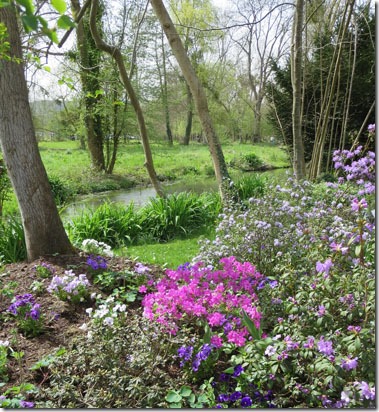
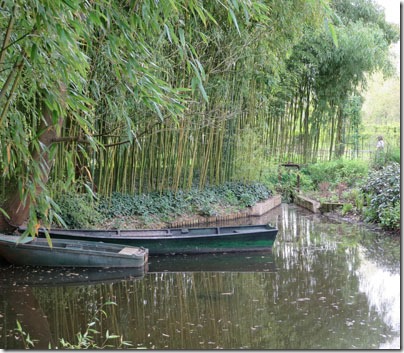

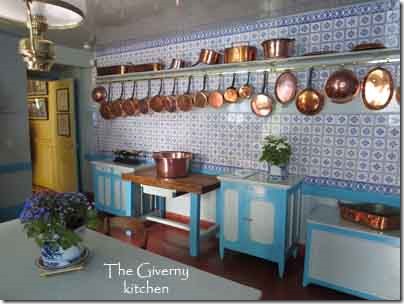

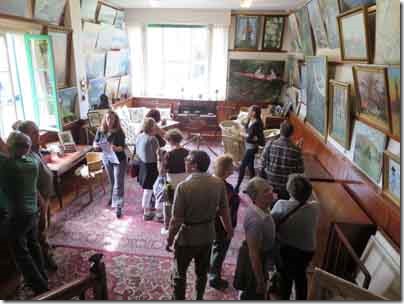
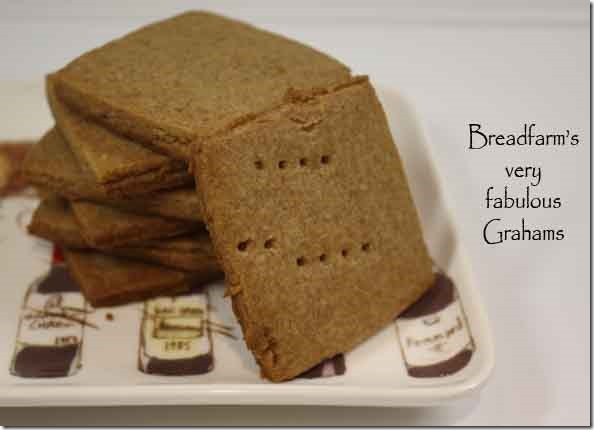
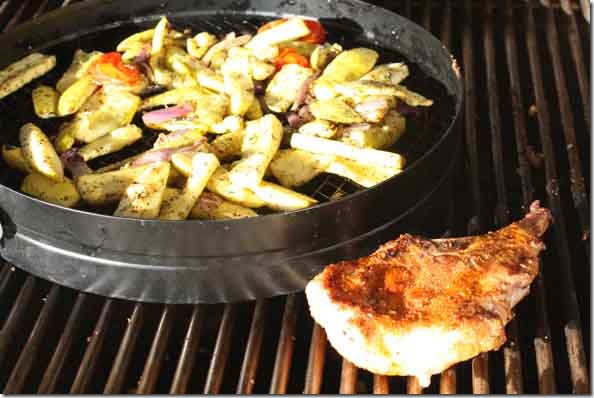
Leave a Comment!